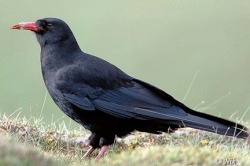Ravens

Ravens are a popular motif in literature, culture, and mythology. They are featured as important symbols in several notable works such as Edgar Allan Poe’s poem “The Raven,” as well as the works of J.R.R. Tolkien, Charles Dickens, and Stephen King. Although natives of northwestern North America and northeastern Asia prize the raven as a god and a trickster, most Western cultures see ravens as bad omens. They are associated with death and other dark symbols. In dream context they predict unfortunate events that will come to pass. The red-beaked raven spotlighted in Balzac and the Little Chinese Seamstress is most likely a Red-billed Chough, a member of the crow family. This species can be found on the mountains and coastal cliffs of Ireland, Great Britain, southern Europe, North Africa, India, and China. It appears frequently in the novel, both in Ma’s dreams and in reality. It can be said that the raven foretells the fate of the Little Seamstress because it is ominously present every time Luo crosses the perilous ridge to visit his love. In one of Ma’s dreams, Ma is on the ridge with Luo and the Little Seamstress. After searching for the raven, he looks back and finds that the seamstress has vanished. The red-beaked raven in the story may also represent the Little Seamstress’s enlightenment. In Chinese mythology, the raven is a solar symbol that lives in the sun and portrays its three phases: rising, noon, and setting. The seamstress herself went through a similar set of transformations. There is another story in northwestern native mythology of the raven bringing sunlight to a dark world. This can be equated with how Balzac and the other forbidden authors’ tales brought on a personal and educational edification for the Little Chinese Seamstress.
